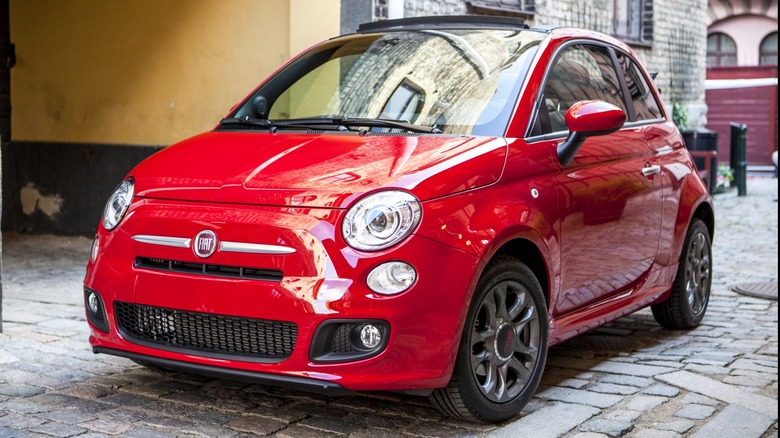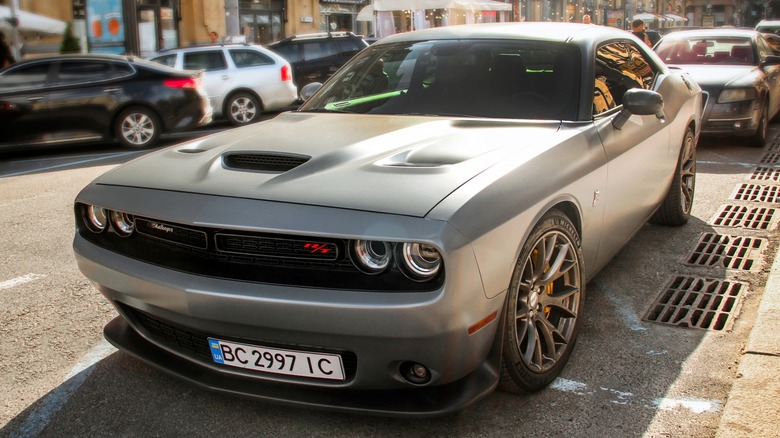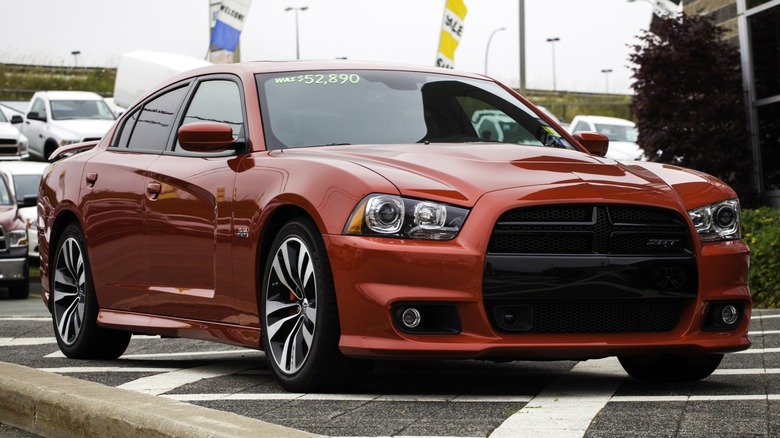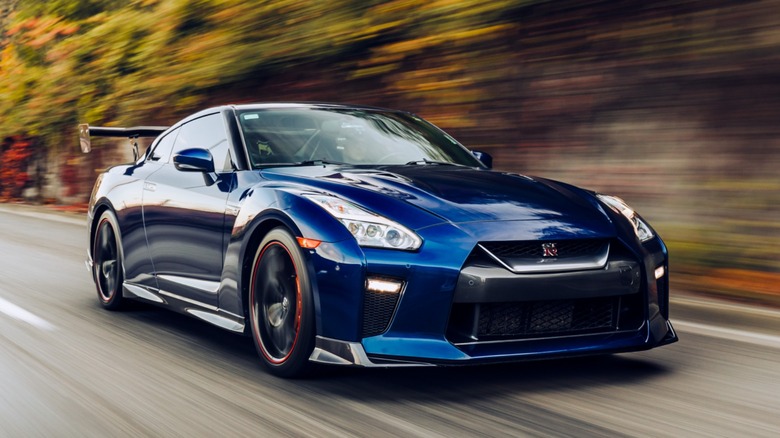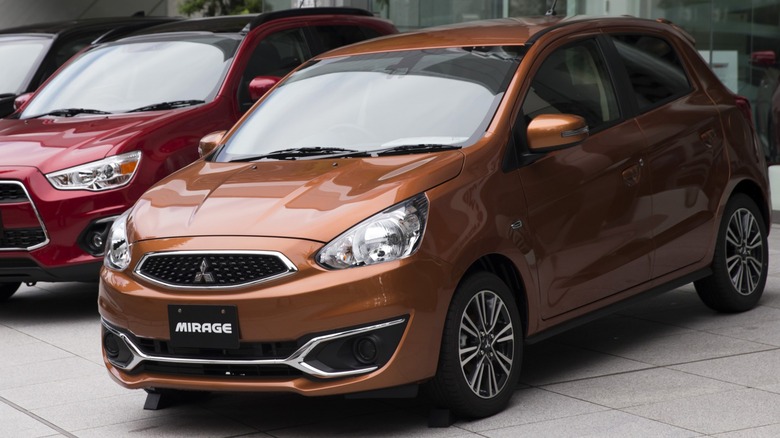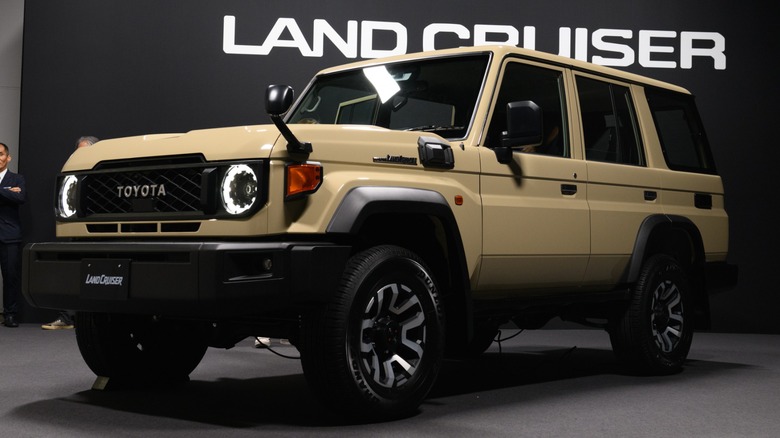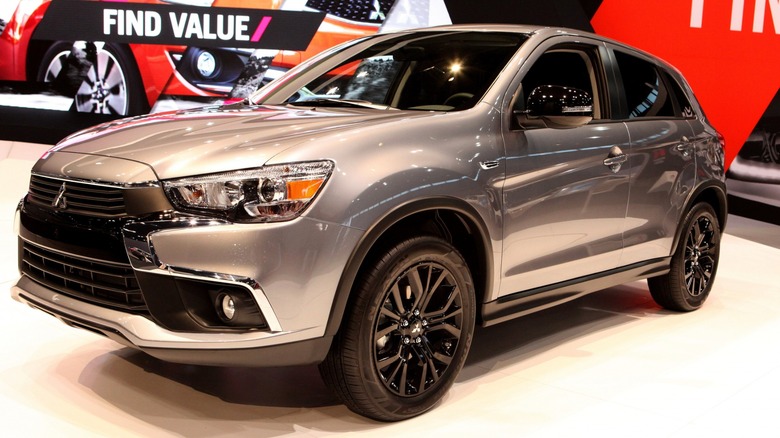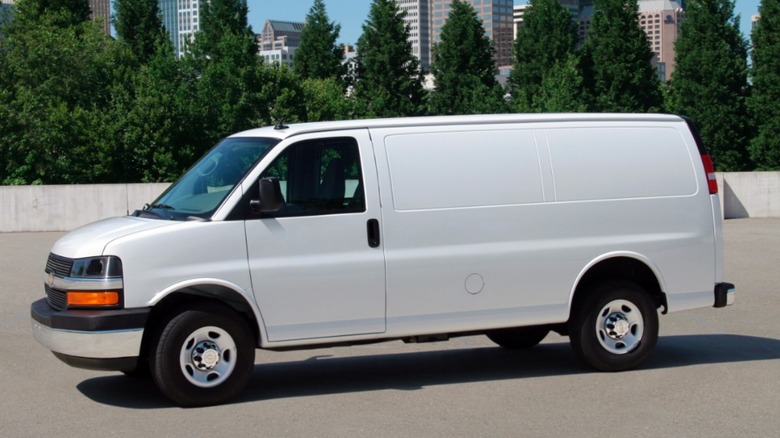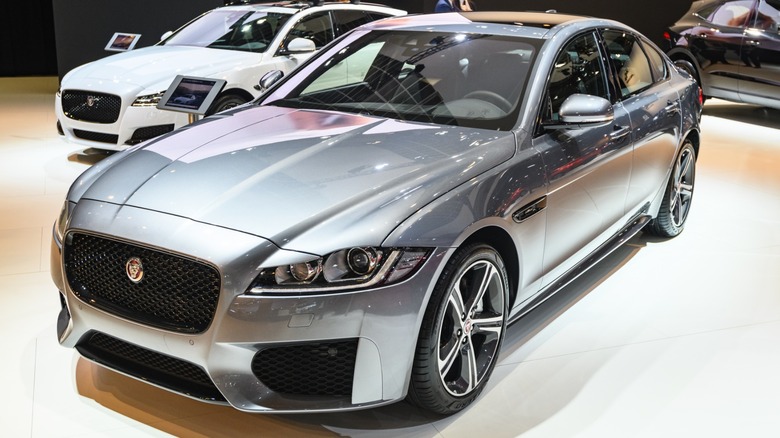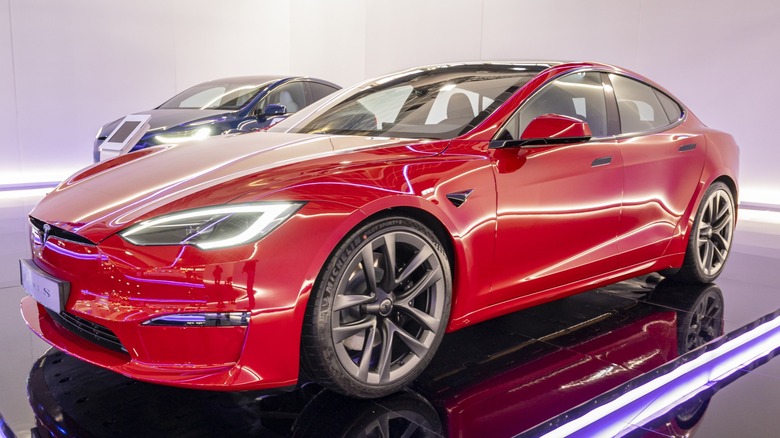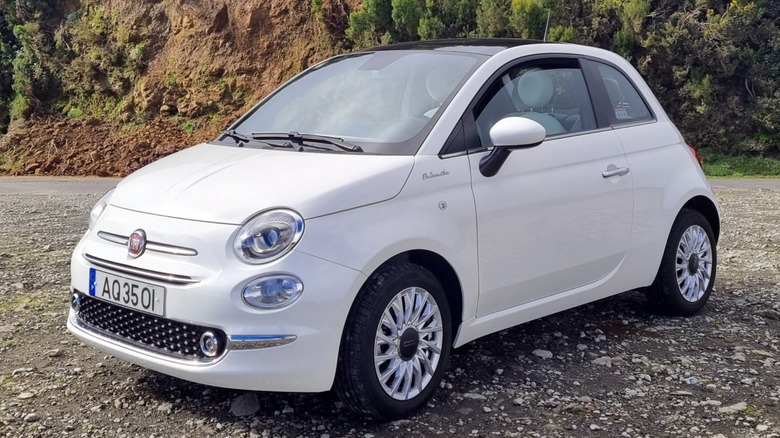10 Of The Most Outdated New Cars On The Market Today
Whenever a new car is first parked on the front line of any dealership, it represents the culmination of years of work by hundreds of people, from designers to welders to engineers, who all put in their part to create a finished product. This process is large and unwieldy, requiring the input of dozens of people to green-light the various designs that come together to create a new car. However, with so many manufacturing so many new cars each year, the monumental effort that goes into each car can appear trivial. Furthermore, the process from a blank sheet of paper to a completed vehicle rolling off the assembly line is also a significant investment, which can run into the billions for modern cars.
Despite all the work and money poured into a new platform, the architecture upon which several models of cars may be built, progress marches forward, and today's platform can quickly become old news. A vehicle platform can serve as the foundation for a range of models and is generally inextricably tied to a selection of engines and suspension components. Platforms can be used as the basis for upgrades and overhauls, with those changes resulting in what is essentially a new platform.
This cycle of change often sees updates averaging every 6.7 years, but some cars soldier on for much longer with the same underlying technologies. The platform on which a car is built is a well-defined metric to determine the age of a particular model, technically speaking. And with that metric in mind, we can say that these are the 10 most outdated cars on the market today.
Dodge Challenger
When Dodge debuted its Challenger muscle car back in 2008, it caused quite a stir in the automotive media at the time. With styling so closely resembling the iconic model of the early '70s, it was part of a retro revolution that swept the auto industry back then. While many of the retro-styled cars of that period failed to gain much traction — think Chevy SSR, Ford Thunderbird, or Plymouth Prowler for examples of failure — the Challenger proved it could live up to the original with a slate of new engines, including the modern HEMI.
The Challenger gained a lot of attention first for its looks and then for its performance. While other retro cars of the day received upgrades and updates that changed with the times, the Challenger has retained its same basic shape with a few mild refreshes over the years. It has also remained current with the introduction of engines with enormous output, including the 800-horsepower SRT Hellcat Redeye.
Even though the engines have become wildly powerful through the regular upgrades of technology, all of this still sits on the same bones as the Challenger from 2008. Stellantis, the parent company of Dodge, has announced that production of this model will end in 2023. This makes the Challenger platform unusually long-lived, with 15 years of production by the time it is retired.
Dodge Charger
In 2005, the first Dodge Charger went on sale since the name had been retired in the '80s. While all previous Chargers had been coupes, this new one was a sedan and broke onto the scene with bold and angular styling that struck a chord with buyers and found much-needed success for the automaker.
The new sedan was the first car to ride on Chrysler's LX platform, which would also sit beneath the Dodge Magnum, Challenger, and Chrysler 300. The base model came with a 250-horsepower V6, but buyers could opt for a 5.7-liter HEMI V8 with 340 horsepower. While both of those engines beat the output of sports cars of a decade before, the addition of the SRT8 model with a 6.1-liter HEMI and 425 horsepower — the same as the 426 HEMI Charger of 1968 — signaled that Dodge meant to regain the notoriety for muscle car performance it once had.
The LX platform the new Charger was originally built upon received generous changes for the 2011 model year. This was largely done to allow for the inclusion of all-wheel-drive models while much of the original engineering remained intact. It was so similar that the rest of the car mostly remained the same as previous models, with some aesthetic changes to update the styling. That makes the platform of the Charger 18 years old now and with an unclear future. The LX platform is scheduled to be retired by the end of 2023, although Dodge teased an all-electric Charger SRT Banshee in August 2022. Although, it will be an all-new car.
Nissan GT-R
In Japan, buyers for many years have had the opportunity to visit a Nissan dealership and take home one of the most coveted cars to come from that country, the Nissan Skyline GT-R. In its last iterations around the turn of the century, it came with a straight-six, making just under 300 horsepower, good looks, and great handling. After a short hiatus, Nissan brought it back to market for the 2008 model year and renamed it the GT-R.
The U.S. market finally had access to this legendary model, which had grown up a bit and came with a twin-turbo V6 producing 480 horsepower sent to the wheels through a new dual-clutch six-speed transmission. Nissan had also made this an all-wheel-drive car and installed Brembo brakes to help slow through the corners and tame its immense power on demand. By the time the 2020s kicked off, horsepower had risen to 565, with the Nismo edition boasting 600.
The price of the GT-R has always been high, especially compared to the average Nissan model on the lot. This means it was never going to be a big seller. Even so, Godzilla is still for sale and remains a highly impressive car, but basically the same car that arrived nearly 16 years ago. It has received touch screens and updated engine electronics with tweaks to the suspension, but it's probably time for something new, especially with such modern options as the C8 Corvette for about the same money.
Mitsubishi Mirage
On a list of cars on sale today that are the most desirable, attractive, and powerful, the Mitsubishi Mirage is certainly to be left off. The features of this car may seem alright at first glance. It has a touchscreen infotainment system with Apple CarPlay and Android Auto, forward collision warning with automatic braking, and automatic climate control. It also has doors that open and tires filled with actual air. With a base price starting at $17,000, you might question what's not to like about it. But if you test drive it, everything will become very clear.
The Mirage's purpose on Earth is to be as cheap as possible. Its interior feels cheap and chintzy, and the power rating of its three-cylinder engine is more of a suggestion of power rather than a genuine output of power. Furthermore, the CVT keeps the underpowered engine revved high in an attempt to squeeze whatever power possible out of it, according to Car and Driver. This means it is also incredibly unbearably noisy.
However, because it is extremely small and light and has just a 1.2-liter engine, you can enjoy up to 42 miles per gallon — its only highlight. Part of why it can be offered so cheaply is that it has been stretching the years out of its base platform for years, with the first Mirage going on sale in 2014. Though much nicer cars have gone longer without updates, that is more likely because people actually want to buy them instead of feeling like they have no other choice due to budget.
Toyota Land Cruiser 70 Series
Shortly after WWII, Toyota and, indeed, the country of Japan at large found themselves in a state of ruin in which industrial production needed to get started and ramped up quickly to bring things back to a place of normality. One of the first vehicles Toyota built was modeled heavily after an American military Jeep captured in the Philippines years before the war's end. This would eventually become known as the wildly successful Land Cruiser.
Over the years, the Land Cruiser would be upgraded with better mechanical ability while also becoming more upscale to the point that late-model Land Cruisers could be considered luxurious. They were instrumental in conquering everything from deserts in Africa to the vast wilderness of northern Canada. The problem is that this type of vehicle is still needed, and often, the most modern Land Cruisers are just too expensive and complex.
While unavailable in North America, Toyota still offers one of the oldest platforms on sale today in its Land Cruiser 70 series. First introduced in 1984, these rugged machines are built with much less complex components on a platform that has proven itself able to tackle extreme environments. The interiors have been updated and refined to match modern tastes, though the engine has been a proven diesel in production for decades. It is still sold in Africa, the Middle East, and Australia — and Toyota of Gibraltar is a major supplier of these to the United Nations and other organizations working in remote areas of the world.
Mitsubishi Outlander Sport
Mitsubishi's North American lineup of cars has dwindled much over the years. Only four models are offered today, including three crossovers and one outdated subcompact. Mitsubishi introduced the Outlander compact SUV in 2003, and it remains the company's top model on sale today. However, in 2010, it introduced another smaller SUV dubbed the Outlander Sport, which is also the ASX in other markets.
There may not be a lot to be said about this vehicle. It is a small and practical crossover that offers affordable efficiency with adequate power from a range of 1.6 to 2.2-liter engines, with gas or diesel options, depending on the market. The debut model came out in 2011 and received an update for the 2016 model year and again in 2020. Despite receiving these updates, the platform remained the same. Though the updates ensured it would remain aesthetically competitive with other cars on the market, it continued to ride on an older foundation.
A new platform was introduced in 2023, and it came about as a result of a technical partnership with Renault. The new ASX is mostly a Renault model with Mitsubishi badging. Despite this all-new platform being used, the old model continues to be offered by Mitsubishi Motors America as a 2024 model on its official website. While it may not last much longer, the 2024 Mitsubishi Outlander Sport is still based on a 13-year-old platform.
Chevrolet Express
Chevrolet has been a supplier of work vehicles for its entire history. Trucks and vans have been integral to its business as well as to the business of America. One of these trusted machines is the Chevy Express. While it built full-size vans for passengers for many years, that market has been ceded to the minivan market, and large vans are now exclusively for work. Furthermore, with the Express being largely based on a truck frame, it is easy to continue to build with many shared parts.
Incredibly, this model first went on sale as an all-new design in 1996, only receiving a single update in 2003. Since then, it has soldiered on as a workhorse with no aesthetic changes to the exterior. Only the interior has seen any changes, and they are marginal at that. Since 2003, the Express has received a redesigned steering wheel, stereo, and climate control. Otherwise, it is exactly the same as it was during the first Bush administration.
While the Express has received engines with updated technology and better efficiency along the way, plans have not yet been announced for its replacement. According to The Drive, Chevrolet is looking at keeping this through 2026 before looking at an alternate platform, making it one of the very few vehicles to make it to 30 on its original foundation.
Jaguar XF
Jaguar replaced its long-running and iconic XJ luxury sedan model in 2007 with an all-new XF. Since 1968, the XJ has been the perfect blend of fine English luxury and sporty driving. The new XF had big shoes to fill, especially since ownership of the manufacturer was transferred from Ford to the Indian automotive conglomerate Tata Motors a year after its introduction.
Tata proved to be a good steward of English motoring heritage as the XF proved to be a popular replacement, receiving regular upgrades of styling and technologies. The original model continued production through 2015, receiving a styling refresh in 2012. A completely upgraded new model hit dealer lots in 2016 with a choice of turbo 2.0-liter four-cylinder or supercharged 3.0-liter V6 engines, although European markets also received a diesel option. Jaguar also added all-wheel-drive as an option and gave the cars advanced eight-speed automatic transmissions.
The second generation of the XF continued to up the ante of English luxury, providing drivers with well-appointed interiors of fine craftsmanship while retaining the sportiness Jaguars are known for. The XF introduced in 2016 was updated in 2021 and remains on sale through the 2024 model year. However, after eight years of production on the same platform, Jaguar will retire it. Plans to upgrade the current XF are not in the works as the company will be switching all automotive production to electric propulsion in 2025, ending 75 years of internal combustion engine production for good.
Tesla Model S
It would be hard to argue that the Tesla Model S had little impact on the automotive landscape. Hailing from a fledgling tech startup that began with building expensive electric sports cars based on an existing Lotus chassis, the success of the Model S was never guaranteed. Yet, continued innovation and dedication to expanding the widespread adoption of the technology helped the company persevere through intense headwaters.
Today, the Model S often serves as the benchmark for a production EV, although the market is now populated with a wide range of options. Luxury carmakers such as Mercedes-Benz and Audi have entered the market with highly competent models, and Porsche and Lotus appear poised to take over the ultra-high-performance end of the market. Regardless, continued updates and innovation have kept the Model S fresh. The development of full self-driving and the release of extreme cars like the Model S Plaid show that Tesla still has plenty to do with its debut mass-market car.
Despite the continued development, the Model S was first released in 2012, making the platform 11 years old, and no plans to retire it have yet been announced. Eleven years is a long time in the world of automotive development. What to think of that may not be so straightforward. Does it mean Tesla is behind the game in refreshing its cars, or does it mean EV platforms have a longer shelf life before major revisions are needed? Time will tell. Perhaps the Model S will continue for another decade before an update is necessary.
Fiat 500
In the post-war period in Italy, industry had been ramping up production of all kinds, with automotive manufacturers working on new models to get Italians moving. Fiat's ingenious creation, heeding the call for affordable transportation, debuted in 1957 as the Fiat 500, or Cinquecento in Italian. It remained in production until 1975. The little car was popular at the time, and the love of nostalgia prompted Fiat to bring it back as a modern version in 2007 for its 50th anniversary.
While the original Fiat 500 was an all-new car back in 1957, the reborn Fiat 500 rode on the same chassis as the contemporary Fiat Panda. Despite being the smallest car offered by Fiat, the 500 avoided the fate of most small cars, being considered nothing but small, economical, and highly undesirable. In contrast, the new 500 became a big seller and continues to be beloved by people all over. The diminutive size contributes to its overall style, which is generally seen as cute and quirky. In 2007, when it debuted, retro cars were a popular trend, and while the trend has largely faded, the 500 retains its charm and popularity.
Fiat gave its little car a facelift in 2015, although the changes were purely aesthetic and relatively small. The interior has seen upgrades while more technology is now standard onboard. However, the same structure sits beneath this little car just as it did in 2007. North American production ended in 2020, but it remains on sale in Europe in hybrid and all-electric versions.
